It’s gettin’ on to summer time and pretty soon many of you will be loadin’ up supplies and the little tykes in the Conestoga and headin’ out on the trail. God bless ya’ll!
So, for the next few weeks I’m gonna feature a few places in the West I hold near and dear to my heart. Places I consider home, as do many of the characters in my manuscripts.
I can’t even count the number of times I’ve been to the location featured today, and I’ll probably go just as many times as I can in the future. It is truly one of the most beautiful places on God’s earth and if you haven’t been, well turn that wagon ‘round and get those mules headed West to Wyoming!
GRAND TETON NATIONAL PARK & JACKSON HOLE, WYOMING 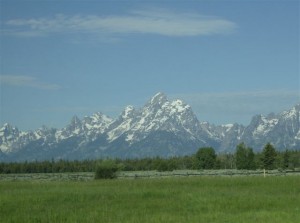
Named for the largest of the peaks the Grand Teton there are three peaks, the Grand, Middle and South Tetons.
Archeological studies show humans arrived in the Teton Range over 11,000 years ago. By the time the first white explorers entered the region in the early 19th Century it was the people of the eastern Shoshone tribes they encountered. For the modern Wind River Shoshone, who continue to maintain close cultural ties to this region, the majestic and snow-capped peaks of the Tetons hold special significance. “In the Shoshone belief system, mountain peaks provide access into the spirit world, where they gain special powers for such things as hunting or healing.”
The first white men who ventured into the Tetons were trappers and explorers. These men will be featured in future posts as each deserves a post to themselves and I’m not sure you’d appreciate a hundred page blog. So we’ll let John Colter, Jim Bridger, John Hoback, Edward Robinson, Andrew Henry, Jed Smith, Jacob Reznor and others take a breather, but we’ll meet them up on the trail a piece.
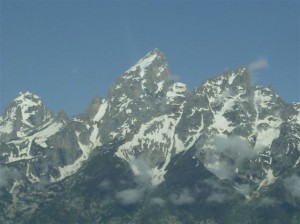 The Three Tetons, were among the most significant landmarks in the fur trade era. By the 1820s, the mountains were known as the Trois Tetons, the Three Paps, or the Three Tetons. It is unkown how these peaks received their names, however it is likely Iroquois or French Canadian trappers from the Pacific Northwest may have been responsible. Two trappers wrote of their first experience viewing these majestic peaks. Warren Ferris saw the Three Tetons for the first time, in 1831, from the Gray’s River south of Jackson Hole. He described them as “three inaccessible finger-shaped peaks of a lofty mountain overlooking the country to a vast distance. . . . Their appearing [sic] is quite singular, and they form a noted landmark in that region.” Osborne Russell viewed the Tetons for the first time from Pierre’s Hole, where they are most visible and distinct. From Russell’s vantage point, the range appeared as “Mountains piled on Mountains and capped with three spiral peaks which pierce the cloud.”
The Three Tetons, were among the most significant landmarks in the fur trade era. By the 1820s, the mountains were known as the Trois Tetons, the Three Paps, or the Three Tetons. It is unkown how these peaks received their names, however it is likely Iroquois or French Canadian trappers from the Pacific Northwest may have been responsible. Two trappers wrote of their first experience viewing these majestic peaks. Warren Ferris saw the Three Tetons for the first time, in 1831, from the Gray’s River south of Jackson Hole. He described them as “three inaccessible finger-shaped peaks of a lofty mountain overlooking the country to a vast distance. . . . Their appearing [sic] is quite singular, and they form a noted landmark in that region.” Osborne Russell viewed the Tetons for the first time from Pierre’s Hole, where they are most visible and distinct. From Russell’s vantage point, the range appeared as “Mountains piled on Mountains and capped with three spiral peaks which pierce the cloud.”
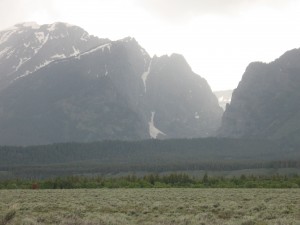 Trappers used the Three Tetons as guides to passes and trails through the valley. Two passes provided access through the Teton Range, Conant Pass, and Teton Pass. The latter pass was the most important. Other important passes were Togwotee, Union, and Two Ocean. Significant routes through the valley were the Hoback Trail, the Yellowstone, and the Gros Ventre River route. Because Jackson Hole is located between South Pass and the upper Snake River country, it was common for trappers to follow the Hoback or Gros Ventre Rivers from the Green River Basin, then cross Teton Pass. Parties traveling from the Bighorn Mountains in the east followed the Wind River and crossed into Jackson Hole via Union or Togwotee Pass. At Union Pass, trappers could turn south, strike the Green River and head south to other profitable trapping grounds. Mountain men entered or exited the Yellowstone country via the Lewis River or Two Ocean Pass.
Trappers used the Three Tetons as guides to passes and trails through the valley. Two passes provided access through the Teton Range, Conant Pass, and Teton Pass. The latter pass was the most important. Other important passes were Togwotee, Union, and Two Ocean. Significant routes through the valley were the Hoback Trail, the Yellowstone, and the Gros Ventre River route. Because Jackson Hole is located between South Pass and the upper Snake River country, it was common for trappers to follow the Hoback or Gros Ventre Rivers from the Green River Basin, then cross Teton Pass. Parties traveling from the Bighorn Mountains in the east followed the Wind River and crossed into Jackson Hole via Union or Togwotee Pass. At Union Pass, trappers could turn south, strike the Green River and head south to other profitable trapping grounds. Mountain men entered or exited the Yellowstone country via the Lewis River or Two Ocean Pass.
In 1872, William H. Jackson took the first photographs of the Grand, Middle and South Teton. In the area to photograph Yellowstone, Jackson took a side trip to the Tetons as Yellowstone had lost something of its novelty. The Tetons, never before photographed, now became more important to Jackson. Jackson and a small party including his assistant, Charley Campbell, John Merle Coulter, the botanist, P J. Beveridge, and a packer named Aleck.
They ascended Table Mountain situated to the west of the three Tetons. The mules carried food and camp gear, while Jackson’s mule, “Old Molly,” hauled his precious photographic equipment. They set up camp at tree line, spent three days exploring the area, and sought a good vantage point for photographic work. While making their way to the summit of Table Mountain, they found their passage blocked by a wall of rock. “On one side was a sheer precipice, but on the other a ledge supported a bank of hard snow, ‘which offered a passage around the wall.’ ” The snowbank formed a dangerous angle, hanging over a sheer drop of several hundred feet. Deciding the risk was worth the view, they first packed a trail on the snow, then carefully guided their saddle and pack animals across the snowbank. Jackson’s photographs of the Grand Teton are among the most famous of his thousands of remarkable images of the American West. The Grand Teton was revealed to Americans for the first time.
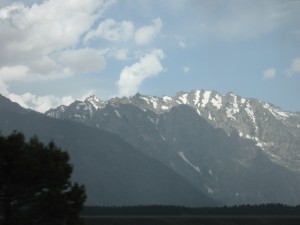 By the time, President Chester A. Arthur traveled through Jackson Hole in 1883 with a large entourage of guides, Indians, cavalrymen, packers, and political cronies, the purpose was recreation rather than exploration. A year after Arthur’s tour, the first settlers entered Jackson Hole, marking a new era in the valley’s history.
By the time, President Chester A. Arthur traveled through Jackson Hole in 1883 with a large entourage of guides, Indians, cavalrymen, packers, and political cronies, the purpose was recreation rather than exploration. A year after Arthur’s tour, the first settlers entered Jackson Hole, marking a new era in the valley’s history.
After years of politics and social disagreements about how to preserve the Teton Range prominent Jackson Hole residents agreed on a plan to protect the Teton Range and six lakes at the base of the range. President Calvin Coolidge signed the executive order establishing the 96,000 acres Grand Teton National Park.
This is barely a thumbnail sketch of the history of the Teton area. But don’t fret, I’ll be covering more in future posts. If you can’t wait for me, a good sketch of the history can be found at www.nps.gov/grte/.
Or heck, treat yourself to a first hand look and don’t forget to visit the towns of Jackson and Dubois while you’re up there. It’s a sight that hits me right in the heart and soul every time. That moment when from a basin blanketed in snow or wild grasses, sage,and flowers rises three peaks touching a vast clear blue sky or their tips hidden by clouds heavy with snow or rain. I always say I don’t need any more pictures of the Tetons, and I always end up taking hundreds more.
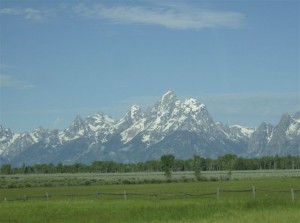 *Information on the Park provided by “A Place Called Jackson Hole.” Daugherty, John. Grand Teton Natural History Association. Moose, Wyoming. 1999.
*Information on the Park provided by “A Place Called Jackson Hole.” Daugherty, John. Grand Teton Natural History Association. Moose, Wyoming. 1999.
**The pictures provided on this page are my own from my last visit to the Tetons** 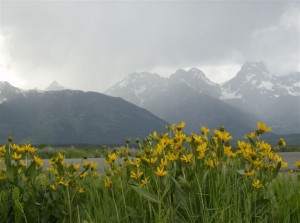





Great article, Kirsten. I love going camping and hiking in the Tetons each summer. We spend about three days there during our annual trip to Yellowstone. And you’re right. Can’t ever get enough photos of the peaks. It is such an awe-inspiring sight!
Thanks, Peggy! Glad you could stop by! It’s always great hearing from another lover of the Tetons and Yellowstone! Sounds like your family has and awesome trip every summer, and you’ve got your wagon headed in the right direction. ;o)
Awesome! Beautiful pics and interesting reading! Thank you 🙂
Thanks, Cecilia! So glad you stopped by and enjoyed the pics and article! :o)
Kirsten, a very interesting read, wonderful photos as well as a great website!
Cheri, I appreciate you stopping by! Thanks for all the kind comments, and I hope you’ll come back soon. :o)